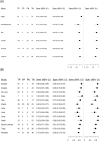Analysis of urinary volatile organic compounds for prostate cancer diagnosis: A systematic review
- PMID: 39323924
- PMCID: PMC11420098
- DOI: 10.1002/bco2.423
Analysis of urinary volatile organic compounds for prostate cancer diagnosis: A systematic review
Erratum in
-
Erratum.BJUI Compass. 2024 Dec 30;5(12):1324-1329. doi: 10.1002/bco2.482. eCollection 2024 Dec. BJUI Compass. 2024. PMID: 39744071 Free PMC article.
Abstract
Context: Prostate-specific antigen is non-specific for prostate cancer. This is improved by multiparametric MRI but a significant amount of indolent prostate cancer is detected by the current MRI pathway and data is emerging that clinically significant cancers maybe missed using a standard PSA threshold. Volatile organic compound (VOC) analysis may offer novel biomarkers for prostate cancer and clinically significant disease.
Objective: To perform a systematic review of the literature to evaluate the current evidence for the use of VOCs as novel biomarkers for prostate cancer and clinically significant prostate cancer.
Evidence acquisition: A systematic search of MEDLINE, Scopus, Web of Science and the Cochrane Library was undertaken by two independent reviewers and papers were assessed for inclusion in the review. Study characteristics, sensitivity and specificity of GC-MS or eNose were extracted. Risk of bias and applicability issues were determined using QUADAS 2 and the quality of reporting using the STARD checklist.
Evidence synthesis: Nineteen studies were included, of which 6 utilised eNose and 13 GC-MS. eNose sensitivity and specificity were 0.71-0.95 and 0.79-0.96, respectively, and GC-MS found a sensitivity and specificity of 0.66-1.00 and 0.53-0.97, respectively. There were concerns about bias in patient recruitment due to differences in the timing of the index test relative to the reference standard.
Conclusion: This review has found promising early results for urinary metabolomics in the detection of prostate cancer. However, there is a need for larger, high-quality studies to validate this. Future work should focus on the detection of clinically significant prostate cancer.
Keywords: diagnostics; eNose; gas chromatography mass spectrometry; metabolomics; prostate cancer; volatile organic compounds.
© 2024 The Author(s). BJUI Compass published by John Wiley & Sons Ltd on behalf of BJU International Company.
Conflict of interest statement
We wish to confirm that there are no known conflicts of interest associated with this publication and there has been no significant financial support for this work that could have influenced its outcome. We confirm that the manuscript has been read and approved by all named authors and that there are no other persons who satisfied the criteria for authorship but are not listed. We further confirm that the order of authors listed in the manuscript has been approved by all of us. We confirm that we have given due consideration to the protection of intellectual property associated with this work and that there are no impediments to publication, including the timing of publication, with respect to intellectual property. In so doing we confirm that we have followed the regulations of our institutions concerning intellectual property.
Figures



References
-
- CRUK . Prostate Cancer Incidence Statistics 2021 [Available from: https://www.cancerresearchuk.org/health-professional/cancer-statistics/s...
-
- Mottet N, Cornford P, van den Bergh, RCN , Briers E, Santis MD, Gillessen S, et al. EAU ‐ EANM ‐ ESTRO ‐ ESUR ‐ ISUP ‐ SIOG Guidelines on Prostate Cancer 2021 [updated 01/03/2022. Available from: https://uroweb.org/guidelines/prostate-cancer/chapter/treatment
-
- Merriel SWD, Pocock L, Gilbert E, Creavin S, Walter FM, Spencer A, et al. Systematic review and meta‐analysis of the diagnostic accuracy of prostate‐specific antigen (PSA) for the detection of prostate cancer in symptomatic patients. BioMed Central Medicine. 2022;20(1):54. 10.1186/s12916-021-02230-y - DOI - PMC - PubMed
Publication types
LinkOut - more resources
Full Text Sources
Research Materials
Miscellaneous
